Related Research Articles

A fuel cell is an electrochemical cell that converts the potential energy from a fuel into electricity through an electrochemical reaction of hydrogen fuel with oxygen or another oxidizing agent. Fuel cells are different from batteries in requiring a continuous source of fuel and oxygen to sustain the chemical reaction, whereas in a battery the chemical energy comes from chemicals already present in the battery. Fuel cells can produce electricity continuously for as long as fuel and oxygen are supplied.

In chemistry and manufacturing, electrolysis is a technique that uses a direct electric current (DC) to drive an otherwise non-spontaneous chemical reaction. Electrolysis is commercially important as a stage in the separation of elements from naturally occurring sources such as ores using an electrolytic cell. The voltage that is needed for electrolysis to occur is called the decomposition potential.

A hydrogen vehicle is a vehicle that uses hydrogen as its onboard fuel for motive power. Hydrogen vehicles include hydrogen-fueled space rockets, as well as automobiles and other transportation vehicles. The power plants of such vehicles convert the chemical energy of hydrogen to mechanical energy either by burning hydrogen in an internal combustion engine, or, more commonly, by reacting hydrogen with oxygen in a fuel cell to run electric motors. Widespread use of hydrogen for fueling transportation is a key element of a proposed hydrogen economy.
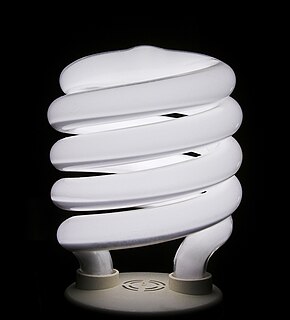
A gas-filled tube, also known as a discharge tube, is an arrangement of electrodes in a gas within an insulating, temperature-resistant envelope. Gas-filled tubes exploit phenomena related to electric discharge in gases, and operate by ionizing the gas with an applied voltage sufficient to cause electrical conduction by the underlying phenomena of the Townsend discharge. A gas-discharge lamp is an electric light using a gas-filled tube; these include fluorescent lamps, metal-halide lamps, sodium-vapor lamps, and neon lights. Specialized gas-filled tubes such as krytrons, thyratrons, and ignitrons are used as switching devices in electric devices.
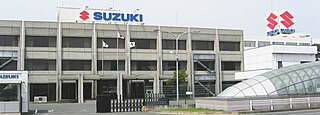
Suzuki Motor Corporation is a Japanese multinational corporation headquartered in Minami-ku, Hamamatsu. Suzuki manufactures automobiles, four-wheel drive vehicles, motorcycles, all-terrain vehicles (ATVs), outboard marine engines, wheelchairs and a variety of other small internal combustion engines. In 2016, Suzuki was the eleventh biggest automaker by production worldwide. Suzuki has over 45,000 employees and has 35 production facilities in 23 countries, and 133 distributors in 192 countries. The worldwide sales volume of automobiles is the world's tenth largest, while domestic sales volume is the third largest in the country.
The hydrogen economy is the use of hydrogen as a fuel, particularly for heating and hydrogen vehicles; and using hydrogen for long term energy storage and for long distance transport of low-carbon energy.
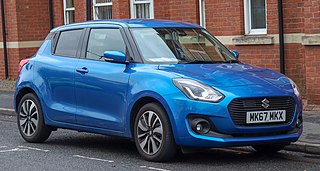
The Suzuki Swift is a subcompact car produced by Suzuki. The Suzuki Swift is classified in B-segment in European single market, segment known as Supermini in British islands. Prior to this, the "Swift" nameplate had been applied to the Suzuki Cultus in numerous export markets.
Hydrogen fuel is a zero-emission fuel when burned with oxygen. It can be used in electrochemical cells or internal combustion engines to power vehicles or electric devices. It has begun to be used in commercial fuel cell vehicles such as passenger cars, and has been used in fuel cell buses for many years. It is also used as a fuel for the propulsion of spacecraft.

A fuel cell vehicle (FCV) or fuel cell electric vehicle (FCEV) is a type of electric vehicle which uses a fuel cell, instead of a battery, or in combination with a battery or supercapacitor, to power its on-board electric motor. Fuel cells in vehicles generate electricity to power the motor, generally using oxygen from the air and compressed hydrogen. Most fuel cell vehicles are classified as zero-emissions vehicles that emit only water and heat. As compared with internal combustion vehicles, hydrogen vehicles centralize pollutants at the site of the hydrogen production, where hydrogen is typically derived from reformed natural gas. Transporting and storing hydrogen may also create pollutants.

Energy transformation, also termed energy conversion, is the process of changing energy from one of its forms into another. In physics, energy is a quantity that provides the capacity to perform work — think of lifting or warming an object. In addition to being convertible,and also according to the law of conservation of energy, energy is transferable to a different location or object, but it cannot be created or destroyed.

Grid energy storage is a collection of methods used to store electrical energy on a large scale within an electrical power grid. Electrical energy is stored during times when production exceeds consumption, and returned to the grid when production falls below consumption.

The Burgman series of scooters is produced by Suzuki with engine capacities from 125 cc up to 638 cc.
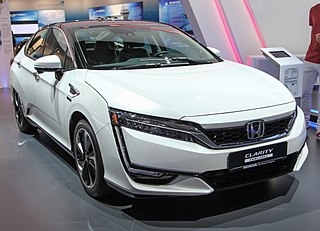
The Honda Clarity is a nameplate used by Honda on alternative fuel vehicles. It was initially used only on hydrogen fuel-cell electric vehicles such as the 2008 Honda FCX Clarity, but in 2017 the nameplate was expanded to include the battery-electric Honda Clarity Electric and the plug-in hybrid electric Honda Clarity Plug-in Hybrid, in addition to the next generation Honda Clarity Fuel Cell.

A turbo generator is the combination of a turbine directly connected to an electric generator for the generation of electric power. Large steam-powered turbo generators provide the majority of the world's electricity and are also used by steam-powered turbo-electric ships.
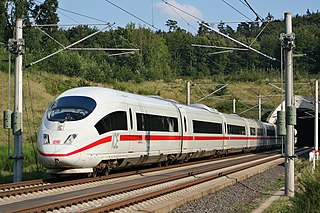
An electric multiple unit or EMU is a multiple-unit train consisting of self-propelled carriages, using electricity as the motive power. An EMU requires no separate locomotive, as electric traction motors are incorporated within one or a number of the carriages. An EMU is usually formed of two or more semi-permanently coupled carriages, but electrically powered single-unit railcars are also generally classed as EMUs. The great majority of EMUs are passenger trains, but versions also exist for carrying parcels and mail.

Who Killed the Electric Car? is a 2006 documentary film that explores the creation, limited commercialization, and subsequent destruction of the battery electric vehicle in the United States, specifically the General Motors EV1 of the mid-1990s. The film explores the roles of automobile manufacturers, the oil industry, the federal government of the United States, the California government, batteries, hydrogen vehicles, and consumers in limiting the development and adoption of this technology.

The Chevrolet Sequel was a purpose-built hydrogen fuel cell-powered concept car and sport utility vehicle from Chevrolet, employing the then latest generation of General Motors' fuel cell technology.

Intelligent Energy is a fuel cell engineering company focused on the development and commercialisation of its PEM fuel cell technologies for a range of markets including automotive, stationary power and UAVs. It is headquartered in the UK, with offices and representation in the US, Japan, India, and China.

The Toyota Mirai is a mid-size hydrogen fuel cell car manufactured by Toyota, one of the first such sedan-like vehicles to be sold commercially. The Mirai was unveiled at the November 2014 Los Angeles Auto Show. As of December 2017, global sales totaled 5,300 Mirais. The top selling markets were the U.S. with 2,900 units, Japan with 2,100 and Europe with 200.